
Awashed by the torrential rains, the cumulus clouds splintered and the horizon emerged like a goddess crowned with jewels of the Divine. Claggy at first, the mystical skyline left the hamlet spell-bound as enchanted denizens watched what appeared to be a dreamy act of the universe. A flat, ice-covered peak loomed over the edge of the mirage end and minutes later, I, like an eccentric devout, stood in front of the majestic panoramic view of the Garhwal Himalayas, consuming its splendid beauty with my naked eyes.
"You have come in the off-season, the best time to visit Kausani is October-November or February-March," our driver Jeena said, diffusing the general perspective that the best time to visit hills is in May or June with the sole purpose of escaping the scorching summer heat of the plains, as he drove us through the meandering roads of the Kumaon region. I was forced to give a second thought to what he just said, cause although we were in hills, the weather was considerably warm. As I eagerly waited for cool zephyr to waft through my face, what my mind could only think of was: "HAD I MADE A MISTAKE?"
Tripping to Kausani was not what I had planned, in fact, a visit to hills was not on our schedule for the whole year. But as Ruskin Bond rightly says, "It is always the same with mountains. Once you have lived with them for any length of time, you belong to them. There is no escape." And, so we were on our way to once again belong to them, to cherish their beauty, to live in their opulence and to subsume ourselves in the glory of Himalayas. The five-hour drive from Kathgodam to Kausani was a tiring one, as we passed by the serene beauty of Bhimtal and Ranikhet. Cutting through the wide expanse of hills in Almora, the half-dried and half-baked Kosi river continued to flow down the valley. Vivid landscapes, terrace farms, floating clouds, dense pine trees and bending roads, the hills welcomed us.

We reached Kausani by five in the afternoon after the long and tiring journey and decided to spend the rest of the evening at our resort The Buransh. Literally nestled in the lap of the hills, the resort offered us a quaint, peaceful and cosy stay. The evening passed-by and night veiled the sky, embedded with an ocean of twinkling stars. Such clear, virgin sky stole my heart and brought alive the poetess hidden inside me. I penned my thoughts and slipped in deep slumber, as the night continued to play its magic. The morning greeted us with sunshine and warmth, as we prepared ourselves for a long day. In the short span of time, I had managed to do my research and fill my to-do list with enormous places. We first headed to Baijnath Temple Complex, which lies on the banks of Gomti river. A short, downhill drive through Garur valley and we were at the ancient capital of Katyuri dynasty, Baijnath, earlier known as Kartikeyapura.

The Katyuris ruled the Kumaon, then known as Kumaonchal or the land of Kurma (Lord Vishnu's second avatar), from 800 to 1100AD. When the Katyuri king Narsingh Deo shifted his capital to Kartikeyapura from Joshimath, he was accompanied by believers and followers of Shaiva sects. The large temple complex, consisting of the temple of Vaidyanath Shiva (Lord of the physicians), was built by the king to provide accommodation to them. Today, the complex is a cluster of 18 temples, with the central one being that of Lord Shiva and the subsidiary shrines being dedicated to Lakshmi-Narayan, Kedareswar and Brahmini Devi, among others. The most exquisite piece of art in the complex is standing statue of Parvati, which is made of grey chloride schist.

The stone temples spoke for themselves, loud and clear, their voices in congruence with the complex's sublime aura of the yore. The Katyuris have disappeared and Kartikeyapura has donned the identity of Baijnath, but the fragments of the lost times still breathe in these temples and the flight of steps to the Parvati temple from the riverside, which was once built by a Katyuri queen. This is the beauty of hills, traversing through their narrow pathways, we not only encounter their vast skyline, adorning the dazzling mountain peaks but also discover ruins and sites, that narrate tales of the bygone era.
Clouds, cumulus and fluffy, started accumulating in the sky and the weather changed its way, as we headed back to the car. The warmth receded and a cool breeze blew. "You are planning to trek to Rudradhari falls and cave tomorrow. But, if we go according to the weather forecast, the rains can descend in the hills either today or tomorrow, most likely tomorrow. It will be difficult for you to trek if it rains tomorrow. Why don't you cover it today," my driver continuously kept on persuading us to reschedule the trek, lest we get caught up in rains, as he drove us to the tea estate.
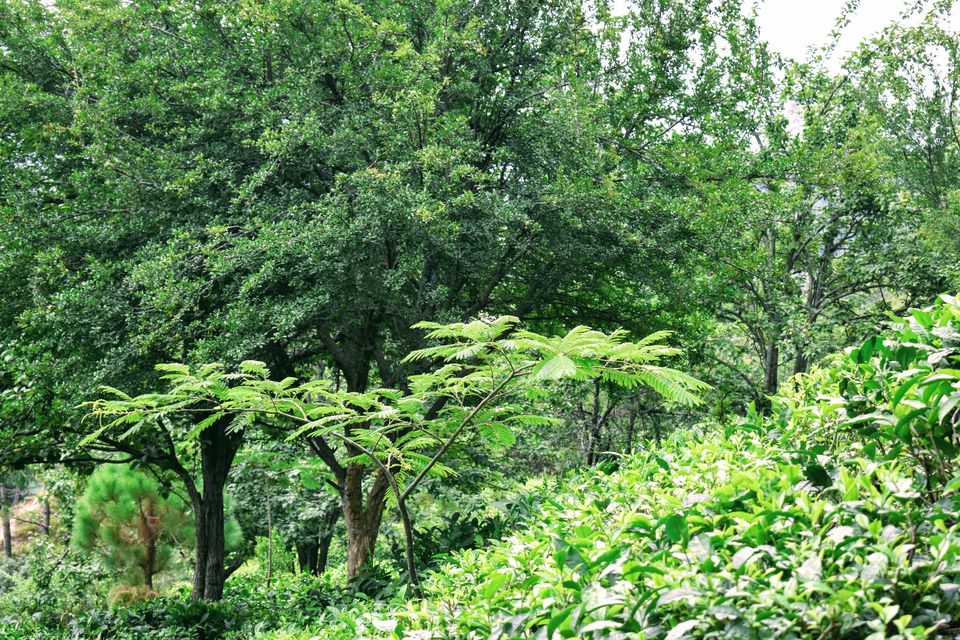
Spread in the wide expanse, the lush tea garden shivered as intense cold breeze gushed through it and sprinkling leaves susurrated. Tea plants covered the sloping of the hills, lining the terraces with their bushes. Women, young and old, after plucking the tea leaves, were hurriedly getting down with their baskets tied to their head. "They were in hurry, but why?," wondered I, "Were they getting late for some work or was it this sudden change in weather? Were they anticipating rains today?" I prayed that any of their anticipations regarding rains would turn false, BUT, unfortunately, they were true! A few pictures later, we were standing under a slightly cracked tin shed roof, stranded in the tea garden, with nothing left to do but admire the rain in the hills. The rains slowed down, we slowly descended the tea plantations and reached for our car.
"The rains have stopped, and it won't rain again today. Tomorrow, we are sure to experience heavy showers, you should visit the Rudradhari today itself," Jeena continued his act of convincing. Finally, we gave in to his persuasion. After consuming a plate of masala Maggi, a top favourite dish in hills, we hired a guide and started off our trek to Rudradhari. A few extremely difficult steps and we were once again greeted by rains, this time they had descended not to drizzle on us but to completely awash us in their torrents. A moderately difficult trek, stepping down through slithering stones was indeed a task in the heavy showers. No matter how much unprepared we were, we stood in front of the falls exactly an hour from where we had started. The falls although not very impressive, hiking through the forest and existing for a particular stretch of time amidst nature's abundance, was a thrilling and satisfying experience for us. Nestled adjacent to the waterfall was a cave temple, which is said to be the abode of Saptarishi Kaushik. We were informed that he has been living and meditating in the cave from years and has been alive on the fruits of the forest.
However, we could not meet him as we were told that he is on a journey and will be back a month later. With stories of the saint in our bag of memories, we started hiking back to where we had started. Through the trail, our guide acquainted us with the different fruits, berries and plants that fell on our way. As we neared the end of the trek, we energised our tired limbs by stealing draughts of fresh water from the nearby spring and gulping them down our throat. Any kind of word would fail to describe the sweetness of the cold, fresh spring water.

Refreshed, we climbed back up to the hill and after sipping tea, decided to go back to our resort. As we drove swiftly through those puzzled roads, my eyes fell upon a shinning speckle over the horizon and in minutes, a glistening range of mountains appeared. Wonderstruck, I shouted, "Here they are – the Himalayas!" Like a snake, who loses its wit in front of its charmer, we stood in bewilderment as clouds hovered over the peaks and slowly, steadily, raising its curtains, presented before us the most magical beauty existent on the earth. It took an hour to get a more unclouded view, the ranges were more clear, more visible, more prominent, more majestic, more encaptivating, leaving the natives, as well as, travellers spell-bound. Panchachulis, Nanda Devi, Trishul, the magnificent peaks of Kumaon Himalayas crowned the sleepy village, sprinkling more magic over its mystical horizon.

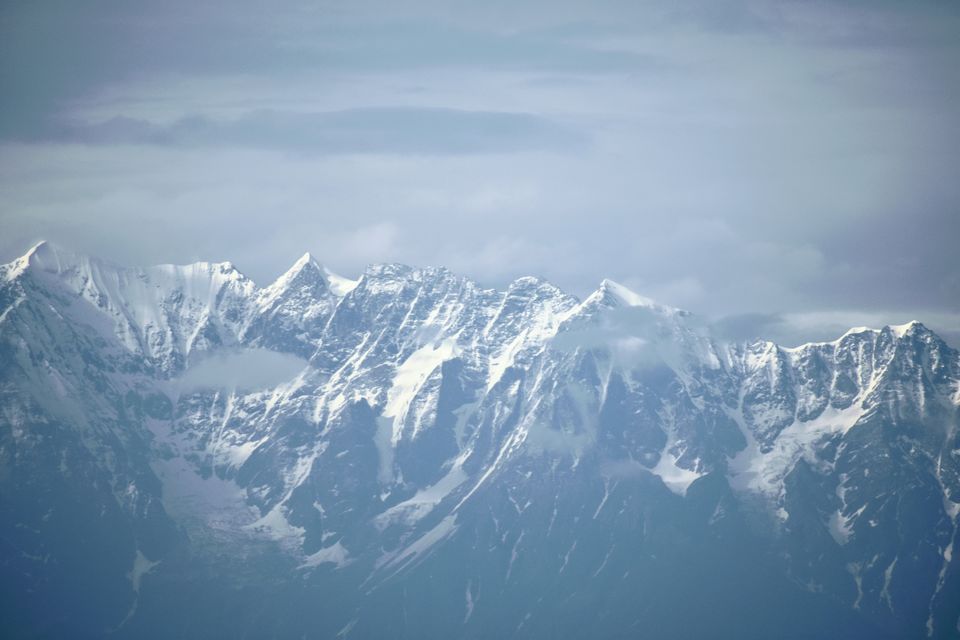
What left me more astonished was that the excitement of the locals was no less than ours. This is the charm of mountains, even though you witness it for end number of times, it leaves you enthralled and mesmerized as it did when you saw it for the first time. You may grow old, but the mountains don't, they remain as new as a bride shrouded amidst a veil of clouds. As the village buzzed about the appearance of the Himalayas, we headed back to our hotel room and lo and behold, we had the splendid and serene Himalayas just before us. Through huge glass windows, we had the best visual treat we could have ever imaged. Blissful!
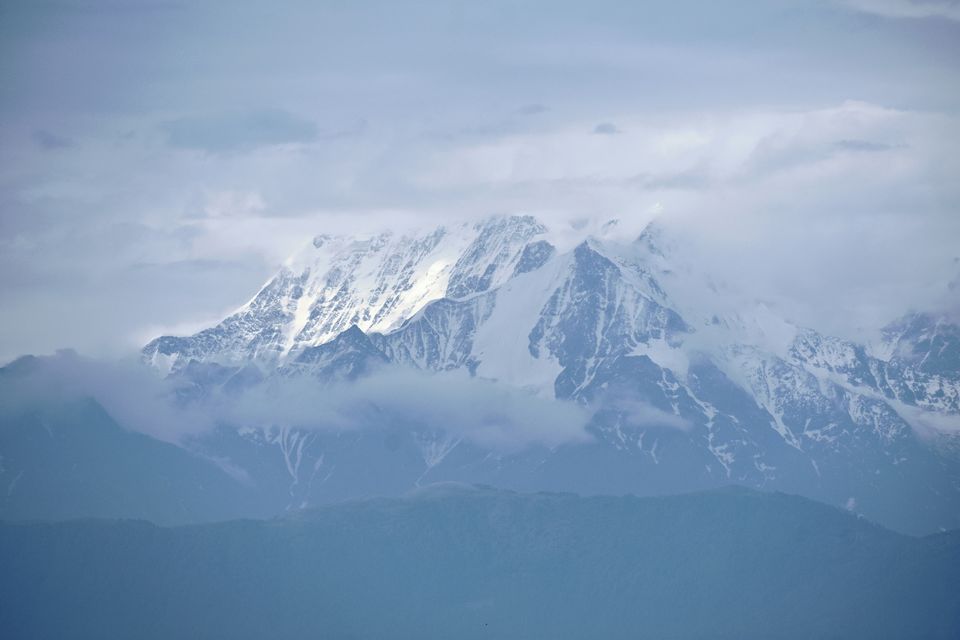
The evening was spent gazing at the mountains and enjoying the chill of the hill station. A silent night enveloped the hamlet and gentle, cool wind continued singing the lullaby. The morning welcomed us with clouds, enormous, fluffy, dense, that had descended on the earth and had settled themselves amidst the lush green valley of the hills. It was accompanied by its best friend, a translucid sheet of fog. The hills are so unpredictable, a day before we had a burst of clear sunshine and now we were amidst clouds and fog.

The horizon continued to sparkle, as the Himalayas shone across it. We decided to drop all our agendas, laze around and witness the glory of the mountains, in stillness. For half a day, what we did was actually nothing, but we did not spend our time amidst the mountains, we existed in those moments in the company of the great Himalayas, cherished its opulence, memorized and re-memorized its beauty and like a mute spectator observed the ephemeral magic of the mountains. Even in their stillness, they appeared to be in transition, with the changing hues of the sunlight.
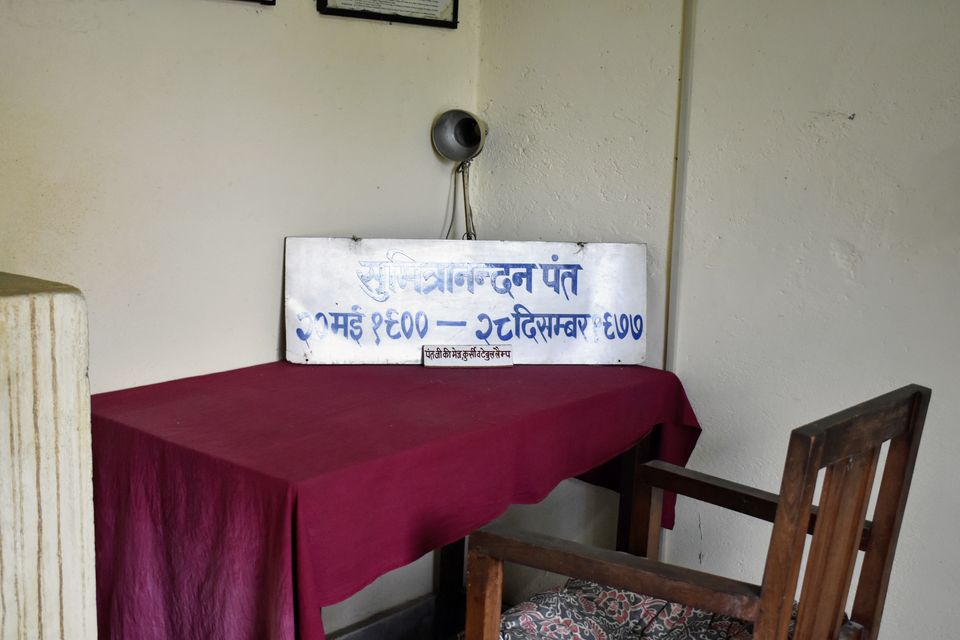
Post-lunch, we headed to the abode of the legendary Hindi poet Sumitranandan Pant. A very interesting staired alley lead to his house, which has now been converted into a museum. Atop the hilly area and enveloped in tranquillity, his house seemed to be a perfect place to sip tea and adore the mountains. The caretaker welcomed us and volunteered to show us the place. He moved from room to room, showing us the places where he studied, where he slept, his belongings and clothes, along with pinned photographs that featured his friends and great poets of those times like Harivansh Rai Bachchan and Ramdhari Singh Dinkar. Adjacent to his room was a large hall containing his collection, "His Library", he called! When I asked him how does he take care of all this, he said, "I have to exhaust my savings to preserve this place. The money given by the tourists also proves helpful, but that's a very small amount. We don't receive any funds from the government. Nobody is concerned about this place."
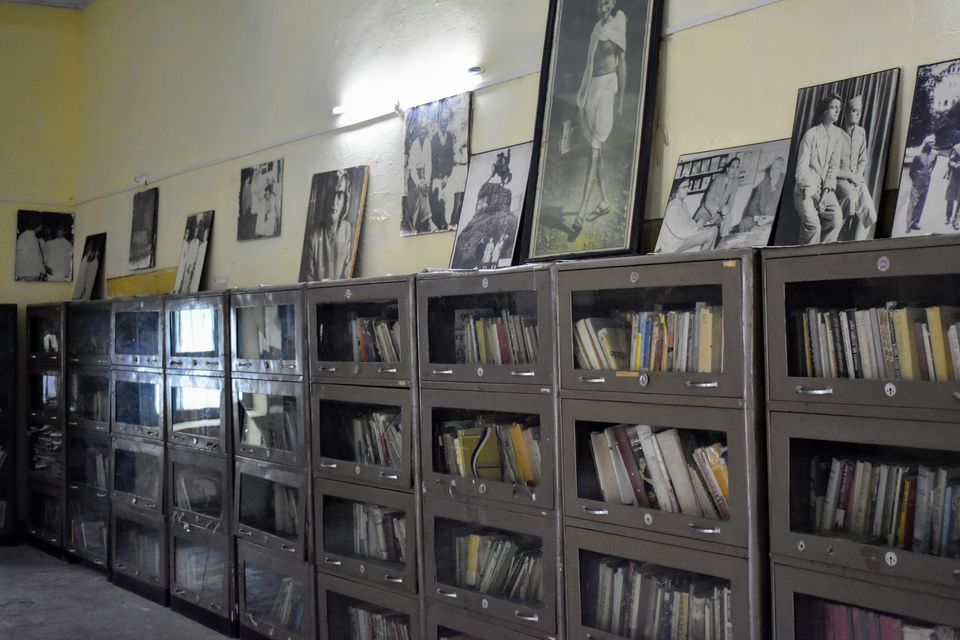
Despite all the hurdles, these locals have been successful in decently preserving the poet's abode. Such places shape the culture of the region and it is important for people to understand their value and contribute their bit in preserving them. My thoughts silently struggled as I found it difficult to understand what made Pant leave this place. "Isn't this the perfect location for a writer to find his or her inspiration. Solitude, silence, an abundance of natural beauty, a perfect environ for a writer to strum a beautiful melody from his words and create one of the finest art pieces in the world," my mind fluttered over these thoughts and suddenly, my self-talk was interrupted by the caretaker. "This is one of the most beautiful locations in Kausani, look how beautiful the Panchachulis look. Do you know why these five peaks are called Panchachulis? It is said that the five Pandavas cooked their last meal here before going to heaven. So 'panch' refers to the five Pandavas and 'chuli' has been derived from 'chulha' or the cooking hearth," the caretaker narrated and we like avid listeners, gave ears to his tale.

Bidding adieu to Pant's abode, we headed to Mahatma Gandhi's Anasakti Ashram, who had called Kausani the 'Switzerland of India'. A simple and quaint place, Anasakti Ashram is one of the best places to view the sunset over the Himalayas. Mahatma Gandhi had decided to stay here for two days, however, the scenic beauty of Kausani compelled him to spend two weeks. During his stay, Gandhiji wrote his commentary on Anashakti Yoga. The ashram was established by Gandhiji's disciple Sarla Behn in 1946, who spent her rest of life here. Along with the lodgings, the ashram campus has a prayer room and a museum, where valuable pictures have been put on display. After spending more than an hour in this serene ashram, we decided to head back to our hotel.

However, our craving for ice-cream made us stop at a small, blue tin-shed cafe, which despite being a part of the hills seemed to be in a complete solace. A trip to any hill station is incomplete without a scoop of ice-cream. Scenic mountains, open tin-shed cafe and a very unplanned ice-cream halt, a perfect sultry evening in hills. Walking back to my resort, as I breezed through the narrow, sloping wooden trail, settled amongst the long pine trees, it gave me immense pleasure, heightening my sense of belongingness to the hills. The hills felt nearer to my heart and I, more intensely wrapped in its bosom.

